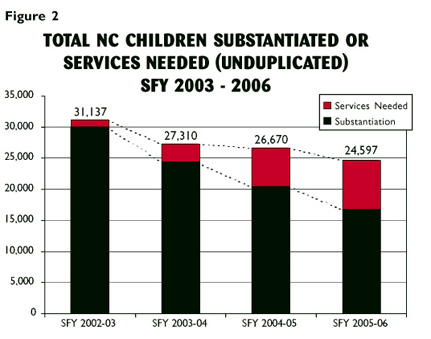 |
 |
 |
©
2007 Jordan Institute
for Families

Vol.
12, No. 2
April 2007
North Carolina Foster Care by the Numbers
To update your knowledge, this article compares North Carolina to the nation in a few key areas related to foster care.
How Many Kids are in Care?
In 2005 there were approximately 513,000 children in foster care in the United States. That’s roughly 7 out of every 1,000 American children (ChildTrends, 2007).
In 2004 North Carolina had the 16th largest foster are population in the U.S., with the children in care in our state representing 2% of all the kids in foster care nationally. In that same year just four states (California, New York, Florida, and Texas) were responsible for 35.5% of the foster care population—more than one out of every three children in care in the country (Pew, 2005).
Cause for Concern?
Nationally, the size of the foster care population is decreasing. Although the number of American children in foster care rose steadily through most of the 1990s, it peaked in 1999, at 567,000, and has declined since then (ChildTrends, 2007).
North Carolina does not reflect this trend. As the figure below illustrates, since 2003 the number of children in care in our state has increased each year. In February 2007 there were 11,436 children in North Carolina in foster care (NCDSSa, 2007).

This increase in the number of North Carolina children in foster care is puzzling if you consider that during this same period the number of children receiving involuntary child welfare services in our state actually decreased. As Figure 2 illustrates, the combined number of maltreatment substantiations and findings of “services needed” has declined since state fiscal year (SFY) 2002-2003.

Because the decision to place children in foster care is made on a case-by-case basis, it would not be accurate to assume that a decline in mandatory services would necessarily result in a decline in the number of children placed in foster care. However, the fact that North Carolina’s numbers are going up while overall U.S. numbers are going down does raise some questions. Are families in North Carolina struggling with more severe issues than other families nationwide? Has something changed in our child welfare system that would affect foster care placement?
At present we do not have a comprehensive explanation, but it is something the Division of Social Services is working to understand. We encourage readers and their agencies to reflect on this issue as well, and to ask questions such as: How do your agency’s foster care placement rates compare with the state’s? If they follow the same general upward trend, why do you think that is?
We believe that foster care placement is a necessary and helpful intervention for many families. But we also know that if it is unwarranted this intervention can cause harm. We owe it to families to monitor our numbers to make sure that our agencies act appropriately to achieve positive outcomes.
Where Are Kids Placed?
Preliminary estimates tell us that across the U.S. in 2005, nearly half (46%) of all foster children lived in foster family homes with non-relatives. Nearly a quarter (24%) lived in family foster homes with relatives—often known as kinship care. Eighteen percent of foster children lived in group homes or institutions, 4% lived in pre-adoptive families, and the rest lived in other types of facilities [ChildTrends, 2007].
North Carolina resembles the nation when it comes to where children are placed. For example, of the 6,074 children who entered foster care in SFY 2005-06, 46% were initially placed in non-relative foster family homes and 26% entered kinship care. Figure 3 provides more detail (NCDSS, 2007d).

How Long Do Kids Stay?
North Carolina does as well or better than the nation when it comes to the length of time children spend in foster care. Nationally in 2003, the median length of time children spent in foster care was 17.6 months (AFCARS, 2006). By comparison, the median length of stay in foster care in our state that year was 14.0 months (USDHHS, 2006).
Data from the Division (NCDSS, 2007c) tell us that the 5,262 North Carolina children who entered foster care during SFY 02-03 left care at the following rates:
• 47% left foster care before one year elapsed:
– 16% left within 90 days
– 12% left between 90 and 180 days
– 19% left between 180 and 360 days
• 26% left foster care between one year and two years:
– 9% left between 360 and 450 days
– 7% left between 450 and 540 days
– 10% left between 540 and 720 days
• 13% left foster care between two and three years
• 14% remained in care after three years
Where Do They Go?
Where do children go when they leave foster care? Preliminary estimates indicate that nationally in 2003, 55% of the children leaving foster care were reunified with their parents or primary caretakers, 11% were placed with relatives, 18% were adopted, 8% were emancipated, 4% entered a guardianship arrangement, 2% were transferred to another agency, and 1% ran away (AFCARS, 2006b).
According to federal data (USDHHS, 2006), the outcomes for North Carolina children leaving foster care in 2003 were similar, although children in our state were more likely to leave care through guardianship (11%) and adoption (23%) than the national average.
To Learn More
We have managed to touch upon only a few of the important numbers related to foster care in North Carolina. For a list of sources you can use to learn more about foster care in North Carolina and in the U.S., click here.